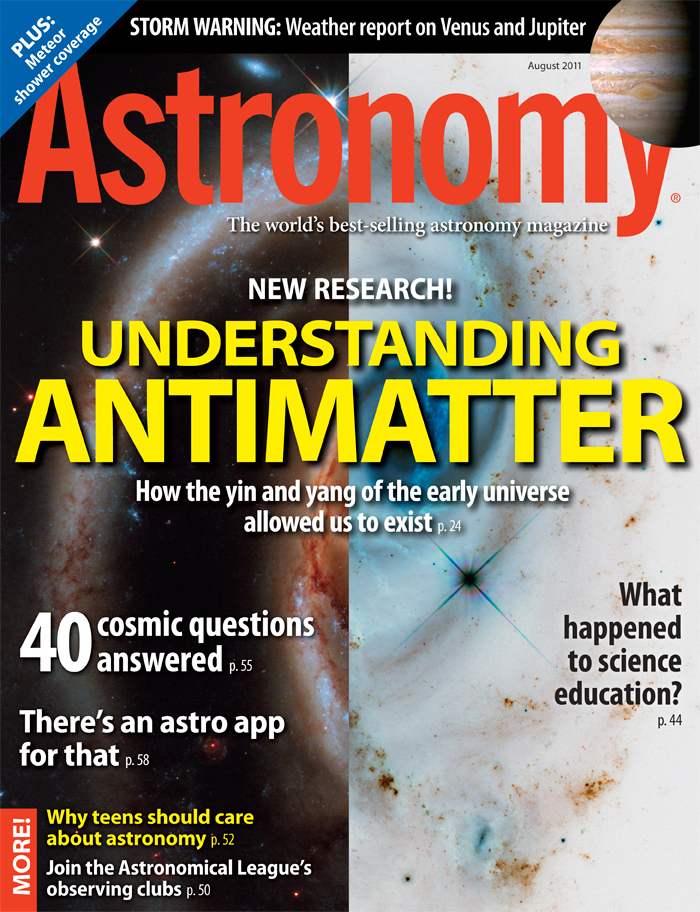
Key Takeaways:
Waukesha, Wis. — All matter and antimatter should have annihilated each other and formed an enormous flash of radiation early in the universe’s history. But matter survived. Could matter and antimatter have slightly different properties, which allowed matter to beat antimatter?
In the August 2011 issue of Astronomy magazine, science journalist Alexander Hellemans explores these questions and what scientists have learned in the past century about antimatter. Antimatter research has especially come a long way in the past decade: A 2001 “discovery of particle-antiparticle pairs that disintegrate at different rates reinforced the idea that matter and antimattter have different properties,” writes Hellemans. Now that the Large Hadron Collider in Europe is up and running, scientists anticipate even more discoveries.
For more information about antimatter and ongoing experiments to uncover its mysteries, pick up the August issue of Astronomy, on newsstands July 5.
“Storm warning”
What’s the weather like on the other planets in our solar system? In “Storm warning,” science journalist and artist Michael Carroll overviews Venus’ broken thermostat, the Red Planet’s polar caps, intriguing colors in Saturn’s cloud decks, and other meteorological features of our planetary system. Scientists can then use information about the other planets to understand Earth’s meteorological system.
“What happened to science education?”
Associate Editor Bill Andrews examines the sad state of science education in the United States and why we should care in “What happened to science educaiton?”. “The level of science education in this country has apparently sunk so low that a significant portion of the populace doesn’t even know how to distinguish verified data from personal opinion, and no one seems to care,” writes Andrews. He explains how we follow the scientific method in daily life, and offers recommendations to help improve science education.
“Why teens should care about astronomy”
Today’s youth seem to put stargazing on the backburner. But some teenagers, like author Ayla Besemer, enjoy astronomy — from the myths behind the constellations, to the pictures telescopes return and the latest scientific discoveries. She shares her love of the night sky, and why she thinks other kids should seek out space in “Why teens should care about astronomy.”
August night-sky events visible without optical aid
- August 13 — The Perseid meteor shower hits its height. Unfortunately, the peak is the same day as the Full Moon, so try to observe the shower a few days prior in the early morning hours.
- August 22 — Neptune is at best visibility for 2011 at 7 p.m. EDT.
Also in the August issue
- “Join the Astronomical League’s observing clubs” — Become a better observer by taking carefully planned tours of the sky.
- “40 cosmic questions and answers” — These quick takes will help you along your astronomical journey.
- “There’s an astro app for that” — Star charts, observing guides, games, and more can turn your iPhone, iPad, or iPod Touch into your best buddy.
- “The Sky this Month” — Exclusive pullout star charts will guide you through the night sky.
- The August issue of Astronomy also includes Astro News, Bob Berman’s Strange Universe, Glenn Chaple’s Observing Basics, David H. Levy’s Evening Stars, Stephen James O’Meara’s Secret Sky, Tony Hallas’ Imaging the Cosmos, Ask Astro, Reader Gallery, Astro Confidential, Deep-sky Showcase, The Cosmic Grid, New Products, Web Talk, and Letters.









